The most creditable aspect of the film is the original screenplay by the director Sorrentino. Sorrentino’s films do not rely on other literary works—these are films on tales he conceives himself. He rarely employs a co-scriptwriter. Both Youth and his earlier Consequences of Love (2004) only credit Sorrentino himself as the sole author and scriptwriter. Such films deserve more respect than those that ride on the shoulders of great writers other than the film’s director since most viewers rarely note this important aspect of the credits, concentrating merely of the story rather than who was the true author and/or the scriptwriter or the originator of the tale.
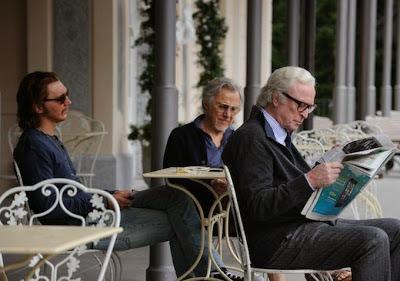
The oldest look most active, the youngest most resigned
(from left to right: Paul Dano, Harvey Keitel, Michael Caine)
Sorrentino’s four important works: Consequences of Love, This Must be the Place (2011), The Great Beauty (2013), and Youth are all inward looking existential tales—more importantly, all are original Sorrentino tales. Each of the films is about memories, each is about human relationships, and each is about human life. In Consequences of Love, the principal character Titta overhears a girl sitting opposite him in a hotel lobby read aloud a passage from a book by Louis-Ferdinand Céline on memories, relationships and life that acts as a catalyst for his actions that follow. In The Great Beauty, the lead character Jep Gambardella, attempts to recall and resolve his life on the lines of the opening quote from Céline’s Journey to the End of the Night, a quote which opens the film-- “To travel is very useful, it makes the imagination work, the rest is just delusion and pain. Our journey is entirely imaginary, which is its strength.” Youth does not specifically refer to Céline’s writings but reflects on similar subjects. In Youth, retired composer/conductor Fred Ballinger (Michael Caine) with just two surviving family members--a wife struck by dementia or Alzheimer’s disease and their daughter Lena facing a crumbling marriage--reflects “I'm wondering what happens to your memory over time. I can't remember my family. I don't remember their faces or how they talked. Last night I was watching Lena (his grown –up, married daughter) while she was asleep. And I was thinking about all the thousands of little things that I done for her as her father. And I had done them deliberately so that she would remember them. When she grows up...in time...she won't remember a single thing.” Those words are not far removed from another Sorrentino film with another interesting original Sorrentino script. In This Must be the Place, the lead character Cheyenne (Sean Penn) confesses on parallel thoughts “I pretended to be a kid for too long. And it is only now that I realize that a father can help and love his child. And that I have no kids makes me really, really sick.” All the four Sorrentino films provide amazing tales for a viewer to contemplate and derive pleasure for a mature, reflective mind.
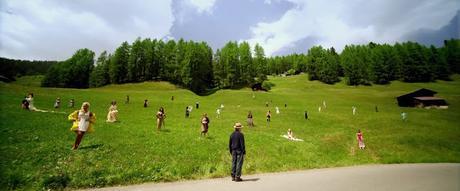
Cinematographer Bigazzi conceptualizes the aging film director Boyle
recalling all the past roles of his leading ladies
in a composite dream shot.
Sorrentino’s four films discussed above are either about relationships or lack of it, in each tale. In Youth, the aging composer Ballinger visits his dementia stricken wife Melanie, who probably is not physically and mentally fit to listen to her loving husband’s soliloquy about their lives “Children don't know their parents ordeals. Sure, they know certain details, striking elements. And they know what they need to know to be on one side or the other. They don't know that I trembled the first time I ever saw you on stage. All the orchestra behind my back were laughing at my falling in love. And my unexpected fragility. They don't know that you sold of your mother's jewelry in order to help me with my second piece. When everyone else was turning me down, calling me a presumptuous, inelegant musician. They don't know that you too, and you were right, that you thought I was a presumptuous, inelegant musician at that time. And you cried so hard. Not because you sold your mother's jewelry but because you sold your mother. They don't know that we were together. You and I. Despite all the exhaustion, and the pain, and hardship. Melanie. They must never know that you and I, despite everything, liked to think of ourselves as a simple song.” That‘s great scriptwriting—“the simple song” at end of that quote is the name of Ballinger’s composition that would fetch him his knighthood in the film. The love of the old couple for each other is contrasted by Sorrentino to the fragile marriage of their young daughter and young son-in-law.
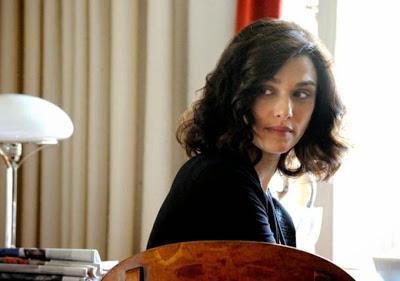
Lena Ballinger, the composer's married daughter, (Rachel Weisz):
"..he stroked my cheek for the first time in my life!"
Sorrentino’s lovely script reverses later for Ballinger’s daughter Lena’s (Rachel Weisz) view of her father (Caine) as she confides in her father-in-law and her father’s close friend Mick Boyle (Harvey Keitel), a film director trying to work out on the filming of his swansong before retiring from active life. Lena tells Boyle about her father ”You know, sometimes when I'm asleep at night, he watches me... and last night he stroked my cheek for the first time in my life. Only I wasn't asleep... I was pretending to be asleep.” And Mick Boyle sagaciously replies: “Parents know when their children are pretending to be asleep.” This conversation for an astute viewer is a flipside of the soliloquy of Ballinger in the room of his sick wife.
The film is equally about aging and memories. Sorrentino’s script includes a dialog between film director Mick Boyle (Keitel) and a young lady admirer of his work where he asks her to view the Alps through a telescope. “Do you see that mountain over there? “ he asks her. “Yes. It looks very close,” is the reply. Again you get a response that underscores aging and memories from Boyle, “Exactly. This is what you see when you're young. Everything seems really close. And that's the future. And now. (He reverses the telescope) And that's what you see when you're old. Everything seems really far away. That's the past.”
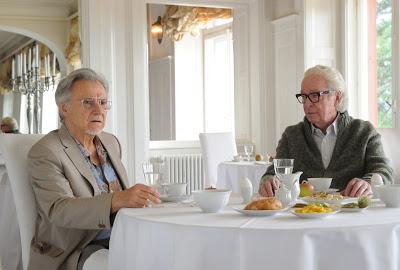
Boyle. the film director, (Harvey Keitel) (left) and
Ballinger, the composer, (Michael Caine)
Sorrentino’s script has two lead characters—one is a composer, the other is a film director. One is interested in music, the other the visuals—both important components of cinema. The younger elements have a different view of cinema than the old. A “Miss Universe” in Youth states emphatically to drive home a point to the older listeners: “TV is the future and the present. Life goes on without all that cinema bullshit.”
The film, as any Sorrentino film would, offers dry wit and visual wit in equal measure. While the elderly lead duo of composer and film director joke about their medical prostrate condition by the amount of urine they discharge each day, they need to be surrounded by young people. Ballinger looks at a Buddhist monk meditating in the garden each day and wryly comments ,“You won't fool me. I know you can't levitate.” Much later in the film, Sorrentino presents the monk actually levitating. A young actor Jimmy Tree (Paul Dano) appears more exhausted than the older hotel guests such as Ballinger, Boyle and a Maradonna look-alike who can kick a tennis ball in the air as he did a football in the past. A statement is made towards the end of the film “You say emotions are overrated. That’s bullshit. Emotions are all that we have.” That leads to a suicide. That’s Sorrentino.
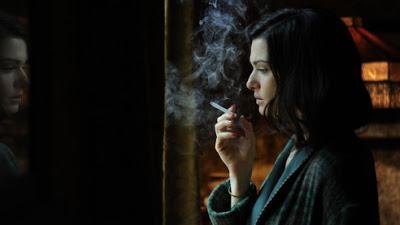
Bigazzi's magic
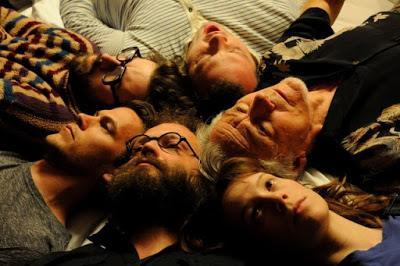
Boyle literally puts his head together with younger minds
in search of a great script for his last film
Cinematographer Luca Bigazzi was responsible for all the four Sorrentino films and his exterior shots are always a treat to watch a she contributes to the surreal humor of the script visually, whether it is the Buddhist monk, the Maradonna kick of a tennis ball, the array of Boyle’s leading lady characters of his past films on the imaginary Swiss countryside or grazing cows with cowbells that bring out memories of composing music in the past for Ballinger. Bigazzi is brilliant in Youth beginning with the introductory close-up of Keitel’s face and ending with close-ups of Ballinger conducting “The Simple Song” to the British royalty, prior to being knighted. Every shot of the film is composed carefully with a twinkle in the eye. Bigazzi and Sorrentino make a fine duo.
The most important aspect of the film was the sound management of the film (as opposed to the music) which adds to the surreal humour of the script. When the emissaries of the British monarchy visit Ballinger in the hotel, the viewer “hears” Ballinger’s true response by the sound of candy wrapper being rubbed in silence. The hotel masseuse responds to comments with silence and the sounds of massaging. The cuckoo clocks seem to have a view of their own. An aged couple who sit at the hotel table by themselves never uttering a word our sound, meal after meal, much to the amazement of other guests are discovered having loud sex in the woods! Youth was top notch in sound management from start to finish and entertains in subtle ways.
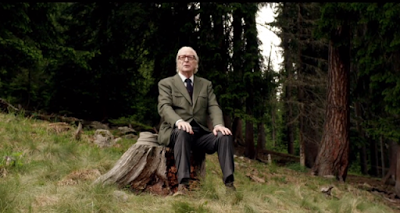
Caine gives his best performance to date as the aging composer,
with a resemblance to Jep and Titta,
lead characters in earlier Sorrentino's films
Youth deserved its win as the best European film of the year. Michael Caine has arguably presented his best best performance to date and deserved the Best Actor award at the European film awards. So did Sorrentino deserve his Best Director award.
P.S. The three Paolo Sorrentino films mentioned in the above review---Consequences of Love, This Must be the Place (2011), and The Great Beauty (2013)--have been reviewed earlier on this blog. Youth is on the author’s top 10 films of 2015 list.

